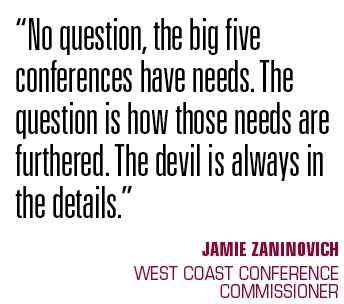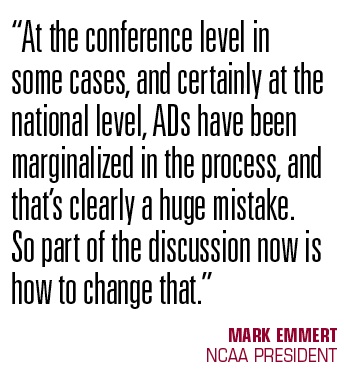The leaders of collegiate athletics aren’t ready to get rid of the NCAA, but they say they are ready to create seismic changes in the way the organization operates.
Those changes include a new model within Division I that would give the five power conferences a new level of autonomy and a way to put more resources toward the student athletes. This comes as leaders worry that the message about the strengths of college sports is getting away from them.
“The media narrative is that athletes are getting a raw deal,” said Pac-12 Commissioner Larry Scott. That’s a false impression, he added, fueled in part by all of the media revenue that’s coming into college sports.
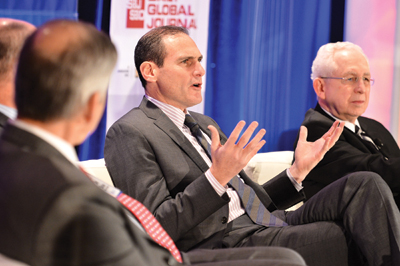 |
The Pac-12’s Larry Scott, with SEC Commissioner Mike Slive and the other commissioners: “The lack of [NCAA] flexibility limits us in supporting the student athlete.”
Photo by: MARC BRYAN-BROWN
|
During two days of panel discussions and hallway conversations at the 2013 SportsBusiness Journal/Daily Intercollegiate Athletics Forum, held last week at New York’s Marriott Marquis, it became apparent that there are few remaining obstacles in the way of a change that would give the power conferences the flexibility they want.
Scott and the rest of the commissioners from those conferences want the freedom to establish guidelines that give them the flexibility to compensate athletes with an annual stipend. Other ideas for the student athlete have emerged, like
putting money into a fund for an athlete’s postgraduate education, feeding them more than once a day and providing them with additional levels of support, the kind of things the NCAA currently doesn’t permit. For once it seemed that a majority of college leaders are on the same page, at least at the highest levels, leaders said.
“Our 65 presidents agree that we need to change things for our student athletes,” said SEC Commissioner Mike Slive. “Change is necessary. A more streamlined NCAA legislative process is essential. We have issues that are unique to us, and I believe other colleagues agree with that.”
Big Ten Commissioner Jim Delany added: “It’s not about money. It’s not about us wanting others’ money. It’s about having legislative flexibility to do what we need to do, such as an educational trust to return to school or full cost of education, areas where we don’t have the full autonomy.”
The next big date on the horizon is next month’s NCAA Convention in San Diego. That’s when NCAA President Mark Emmert said leaders within collegiate athletics will have their most substantive talks thus far about what that change will look like. Emmert also has commissioned a group of university presidents to study potential change.
But as anyone in college sports knows, the NCAA tends to move at a glacial pace, and the idea that anything will happen quickly is misguided.
“The association is certainly more evolutionary than revolutionary,” said Bubba Cunningham, athletic director at North Carolina. “I think we’re going to see the system evolve.”
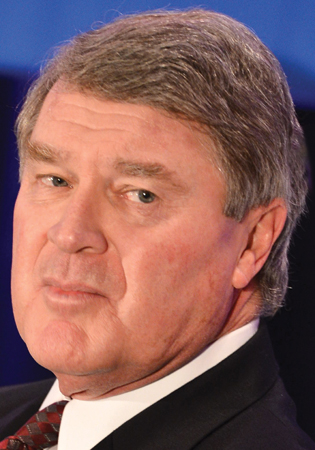 |
SWOFFORD
|
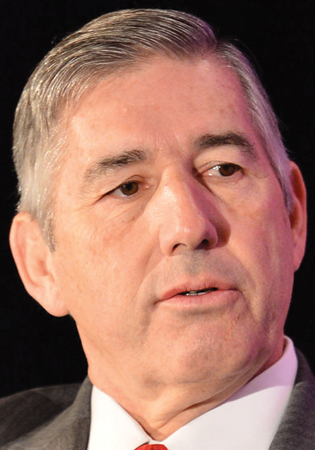 |
BOWLSBY
|
The five power conference commissioners — Delany, Scott, Slive, the Big 12’s Bob Bowlsby and the ACC’s John Swofford — agreed that 2014 will be a year of change for the NCAA. At one point earlier this year, that led to discussion of a subdivision for the top 65 schools in those conferences.
More recently, though, commissioners and university presidents said their preference is to stay under “the big tent” of Division I and not break away into a separate division.
The tone from the commissioners from conferences outside the top five indicated that they’re better off together than separate, as long as there are parameters of the big five’s autonomy. If the conversation is about putting more resources toward student athletes and creating more opportunities for additional sports, they’re all for it.
The commissioners outside the power five don’t want to see fundamental changes that would further uneven the playing field, like adjusting the number of scholarships offered or increasing practice time.
“No question, the big five conferences have needs,” said West Coast Conference Commissioner Jamie Zaninovich. “The question is how those needs are furthered. The devil is always in the details.”
Currently, schools in Division I are required to offer a minimum of 16 sports. North Carolina’s Cunningham would like to see the minimum increase to 24, in part because of the new TV revenue being paid by networks like ESPN and Fox.
Delany, however, said the idea of a subdivision isn’t completely off the table.
“We believe that it’s good for Division I to be together — competitively, branding, revenue-sharing, etc.,” Delany said. “At the same time, it’s going to be necessary to have a cleaner and more nimble system to achieve these changes in NCAA policy in the 21st century to do the right thing for our student athletes. … The only thing it seems you can’t do today is do right by the student athlete.”
Just before the commissioners spoke, Emmert was aggressive in saying that a new governance structure could be in place by this summer, giving those conferences greater autonomy.
Part of that structure would be a much more significant role for athletic directors, a segment that has largely been left out of the decision-making in this era of presidential oversight.
“At the conference level in some cases, and certainly at the national level, ADs have been marginalized in the process, and that’s clearly a huge mistake,” Emmert said. “So part of the discussion now is how to change that.”
He said a new important legislative body would be driven by athletic directors.
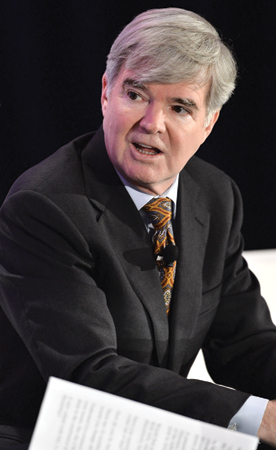 |
Photo by: MARC BRYAN-BROWN
|
“One of the models being considered is a move to a new legislative body with presidents [at the top] — presidents want to retain control of college sports because that’s their job description — but move the legislative policy-making on the day-to-day decisions to a new body that would be dominated by athletic directors,” Emmert said. “It would be quite a different model than we have today.”
But even amid the momentum for change, some preached patience.
“We’re clearly on the verge of something,” said Georgia Tech AD Mike Bobinski. “I’m not sure the January convention will be the seminal event it’s being made out to be. Dealing with the process is one thing, but also philosophically the NCAA has to define its role. It’s not what it used to be. Is it going to be about championships? Is it going to be about safety and well-being? Is it about administering an agreed set of rules? Those philosophical questions have to be answered.”
In addition to the upcoming NCAA overhaul, commissioners and ADs talked at length about the pay-for-play issue that has been such a popular topic in the media. Not surprisingly, they’re unanimous in their opposition to paying the athletes.
“If we go down that path to establish an employer/employee relationship, we will forever sever the relationship between higher education and core curricular activity on campus,” Bowlsby said. “If we go down that way, we will forever have lost our way.”
But Scott conceded that pay-for-play is one of the issues he’s most commonly asked about, largely because of the excess associated with salaries and new facilities.
“We see the spending,” Scott said. “We know that there is spending on salaries and facilities. What we’re saying is we want to provide more support to student athletes. The lack of [NCAA] flexibility limits us in supporting the student athlete.”





